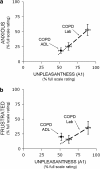Dyspnea affective response: comparing COPD patients with healthy volunteers and laboratory model with activities of daily living
- PMID: 23621986
- PMCID: PMC3663820
- DOI: 10.1186/1471-2466-13-27
Dyspnea affective response: comparing COPD patients with healthy volunteers and laboratory model with activities of daily living
Abstract
Background: Laboratory-induced dyspnea (breathing discomfort) in healthy subjects is widely used to study perceptual mechanisms, yet the relationship between laboratory-induced dyspnea in healthy volunteers and spontaneous dyspnea in patients with chronic lung disease is not well established. We compared affective responses to dyspnea 1) in COPD patients vs. healthy volunteers (HV) undergoing the same laboratory stimulus; 2) in COPD during laboratory dyspnea vs. during activities of daily living (ADL).
Methods: We induced moderate and high dyspnea levels in 13 COPD patients and 12 HV by increasing end-tidal CO2 (PETCO2) during restricted ventilation, evoking air hunger. We used the multidimensional dyspnea profile (MDP) to measure intensity of sensory qualities (e.g., air hunger (AH) and work/effort (W/E)) as well as immediate discomfort (A1) and secondary emotions (A2). Ten of the COPD subjects also completed the MDP outside the laboratory following dyspnea evoked by ADL.
Results: COPD patients and HV reported similar levels of immediate discomfort relative to sensory intensity. COPD patients and HV reported anxiety and frustration during laboratory-induced dyspnea; variation among individuals far outweighed the small differences between subject groups. COPD patients reported similar intensities of sensory qualities, discomfort, and emotions during ADL vs. during moderate laboratory dyspnea. Patients with COPD described limiting ADL to avoid greater dyspnea.
Conclusions: In this pilot study, we found no evidence that a history of COPD alters the affective response to laboratory-induced dyspnea, and no difference in affective response between dyspnea evoked by this laboratory model and dyspnea evoked by ADL.
Figures





References
-
- International Association for the Study of Pain Task Force on Taxonomy. Classification of chronic pain. In: Merskey H, Bogduk N, editor. Classification of chronic pain. 2. Seattle, WA: IASP Press; 1994. p. 210.
-
- Gracely R. Affective dimensions of pain: how many and how measured? APS J. 1992;1:243–247. doi: 10.1016/1058-9139(92)90056-I. - DOI
-
- Price DD, Harkins SW. The affective-motivational dimension of pain: a two stage model. APS J. 1992;1:229–239. doi: 10.1016/1058-9139(92)90054-G. - DOI
Publication types
MeSH terms
Substances
Grants and funding
LinkOut - more resources
Full Text Sources
Other Literature Sources
Medical
Molecular Biology Databases

